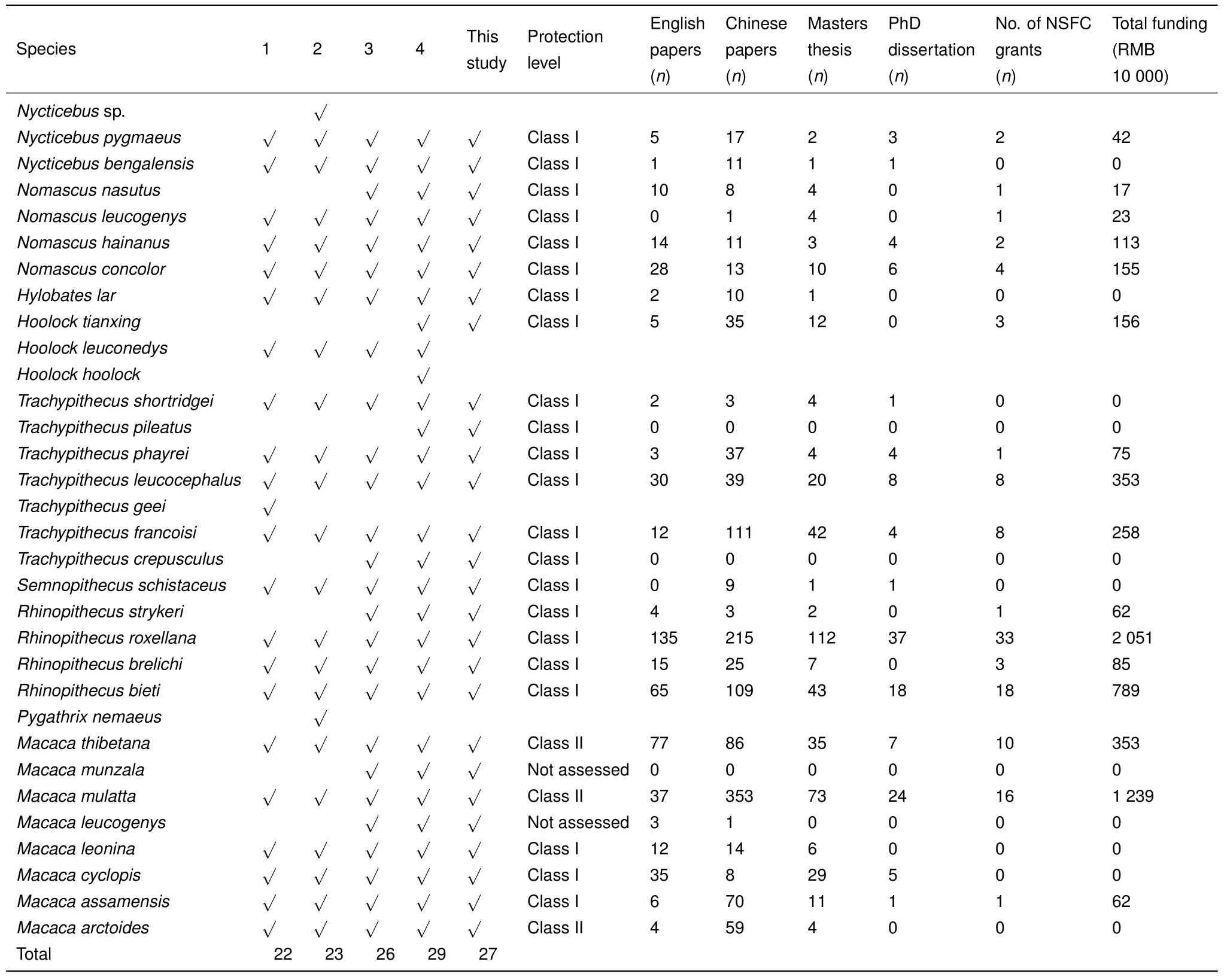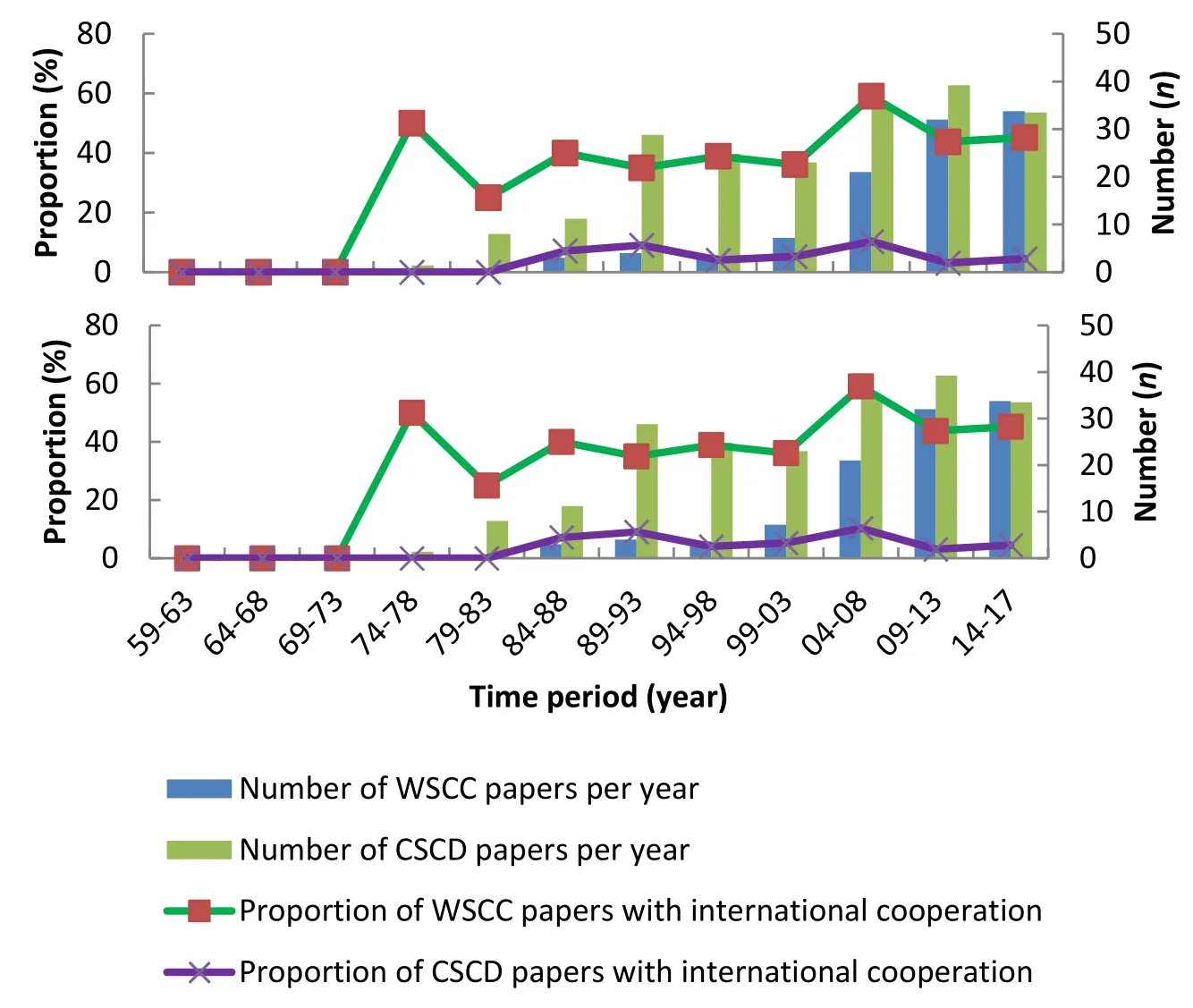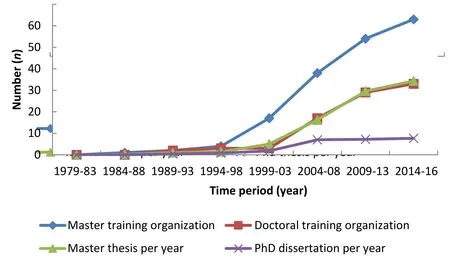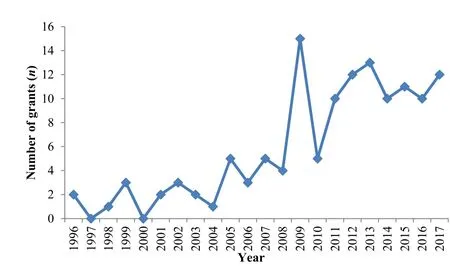Extant primates and development of primatology in China:Publications,student training,and funding
Peng-Fei Fan,Chi Ma
1School of Life Sciences,Sun Yat-Sen University,Guangzhou Guangdong 510275,China
INTRODUCTION
China supports the richest diversity of non-human primates(hereafter primate)in the northern hemisphere.More than 20 species from three families currently reside in China(Table 1),with the discovery of new species and populations still adding to the list.Remarkably,two new species(Hoolock tianxing:Fan et al.,2017;Macaca leucogenys:Li et al.,2015)have been described and new populations of three species(Nomascus nasutus:Chan et al.,2008;Trachypithecus pileatus:Hu et al.,2017;Rhinopithecus strykeri:Long et al.,2012)have been discovered in China since 2006.In total,32 primate species taxa have been reported in China by different researchers(Table 1).The Chinese population of eastern hoolock gibbon(Hoolock leuconedys),once thought to live in western Yunnan(Fan et al.,2011),is now recognized as a new species,known as the skywalker hoolock gibbon(H.tianxing:Fan et al.,2017).Consequently,there are currently no populations of eastern hoolock gibbon in China.Thus,excluding species with unconfirmed distribution(Pygathrix nemaeus,Pan et al.,2007)or disputed taxonomy(e.g.,Nycticebussp.,Pan et al.,2007)and the two species occurring in Indian controlled areas of southeastern Tibet(Trachypithecus geeiandHoolock hoolock,Ji&Jiang,2004;Jiang et al.,2017),there are 27 species of primates in China available for study(Table 1).
Chinese primateslive in diverse habitatsand many populations represent the northern most distribution of the species,genus,or family. For example,R.bietilives in dark coniferous forest above 3000 m in Yunnan Province and Tibet;Trachypithecus leucocephalussurvives in karst forests without surface water in Guangxi;Nomascus concolorranges in mountain forests that can be covered by snow in winter in central Yunnan.In these harsh seasonal habitats,primates have evolved different strategies from their lowland conspecifics or close relatives to cope with ecological and social challenges,such as living in large groups.Snub-nosed monkeys(Rhinopithecusspp.)live in multi-level societies of up to 400 individuals(Qi et al.,2014)and leaf monkeys(Trachypithecus crepusculus)living in seasonal montane forests on Mt.Wuliang form multi-male multi-female groups of more than 100 individuals,whereas their low-land relatives normally live in one-male groups of less than 30 individuals(Fan et al.,2015a). Crested gibbons(Nomascus nasutus,N.concolor,andNomascus hainanus)live in groups with two breeding females in seasonal forests in China,whereas other gibbon populations typically live in adult pair groups with only one breeding female(Fan et al.,2015b;Guan et al.,2018). Populations living in colder or more temperate habitats provide excellent opportunities to study evolutionary and ecological differences in population genetics,nutritional ecology,endocrinology,cognition,and microbiome.

Table 1 Number of primate species of China in different literature
At present,most primates in China are threatened by habitat loss and degradation,illegal hunting,and small population size(Fan et al.,2017;Liu et al.,2015).Except forM.mulatta,Macaca thibetana,Macaca cyclopis,andR.roxellana,all other species have total populations of less than 10000 individuals(Li et al.,in preparation).Two gibbon species have recently become extinct in China(Nomascus leucogenys:Fan et al.,2014;Hylobates lar:Grueter et al.,2009)and the Hainan gibbon has a total population of less than 30 individuals,being the most endangered primate species in the world(Bryant et al.,2016).According to the Chinese Wildlife Conservation Law,22 species are listed as National Class I Protected Species,three species(M.thibetana,M.mulatta,andMacaca arctoides)are Class II,and two species(Macaca munzalaandM.leucogenys)have not yet been assessed(Table 1).Conservation oriented research can provide an informed scientific foundation to support species protection and preservation.
Primatology is the scientific study of both living and extinct primates in either their natural habitats by field surveys or in laboratory experiments to understand aspects of their evolution and behavior(https://en.wikipedia.org/wiki/Primatology).Ji&Jiang(2004)dated the rise of primatology in China back to 1862 when Swinhoe published his paper about mammals from the island of Formasosa(Swinhoe,1862);however,Chinese scientists first studied primates in the 1950s(Shou,1957;Tan,1957).Xia&Zhang(1995)and Ji&Jiang(2004)provided good summaries on the research and conservation of primates in China.Primatology,especially studies of wild populations in China,has experienced a strong development trajectory.Several teams have established field stations and conducted continuous long-term research for more than 20 years.
The Chinese Primatological Society was formally established in 2017.To celebrate this landmark event,we organized this special issue on“Primates and Primatology in China”, which includes studies on gibbons, leaf monkeys,snub-nosed monkeys,and macaques,as well as commentaries from Prof.Paul A.Garber and Prof.Colin A.Chapman.To provide a basic introduction to primates and primatology in China,we briefly review the development of primatology in China through three indices:that is,number of publications,student training,and funding received from the National Natural Science Foundation of China(NSFC).We also consider the current challenges facing primatology development in China.This review excludes studies on extinct species or on primates as medical models.
MATERIALS AND METHODS
We searched for papers published in Chinese journals using the Chinese name of each extant species(including title,keyword,and abstract)within the Chinese Science Citation Database(CSCD)using Chaoxing,a Chinese literature database(http://www.chaoxing.com).We searched for papers published in international journals through the Web of Science Core Collection(WSCC)database(http://apps.webofknowledge.com)using the Latin name of each extant species and refined the results by confining the county/region to “China”,“Hong Kong”,or“Taiwan”.We searched for Masters theses and PhD dissertations in Chinese within several databases,including CNKI,Wanfang(http://www.wanfangdata.com.cn/),Airitilibrary(http://www.airitilibrary.cn),and Chaoxing(http://www.chaoxing.com/),using the Chinese name of each species as the search term. We searched for grants for each species funded by the NSFC since its establishment in 1986(http://www.medsci.cn/sci/nsfc.do,http://nsfc.biomart.cn/).Although primate research has received funding from the State Forestry Administration of China,Ministry of Science and Technology of China,and other organizations,the NSFC is the largest funding source for research and the only open source to which we had access. We also used genus and family names when searching for papers published in Chinese and English,and for grants. We checked each paper and thesis and excluded those using primates as medical models. We also excluded grants for studies of more than one species(n=12)when determining total NSFC funding for each species. We calculated the proportion of international cooperation by dividing the number of papers in which an international organization was involved based on author affiliation by the total number of papers published.We also obtained anecdotal information from primatologists in the WeChat group “China Primatological Society”by asking“who teaches primatology-related courses to undergraduate students”and “who obtained a PhD degree aboard”. We analyzed data and constructed figures using Microsoft Excel 2010.
RESULTS
Number of publications
In total,we found 496 papers published by Chinese authors from the WSCC and 999 papers from the CSCD(http://www.chaoxing.com). Only 15 papers were published in CSCD journals and three papers in WSCC journals before 1979,after which primate studies began to flourish.We observed stable development of Chinese primatology between 1979 and 2003,with China then entering a new phase after the 2002 International Primatological Society meeting held in Beijing.After 2003,Chinese primatologists published a greater number of papers in international journals(WSCC database),and the number of papers in the WSCC database exceeded the number of papers published in the CSCD for the first time between 2014 and 2017(Figure 1).
Chinese primatologists have also actively engaged in international cooperation since the rise of primatology in China.In total,scholars based at international universities and academic institutions have been involved in 228 English papers(46.0%,n=496).The proportion of international cooperation in WSCC papers has remained above 25%over time(Figure 1).In contrast,very few(3.3%,n=999)CSCD papers have included international scholars(Figure 1).
Student training
China commenced student training in primate research after 1979.However,primatology is not a distinct discipline in China,with graduate students who have studied primates receiving their degrees in zoology,ecology,genetics,physiology,and anthropology. The first graduate student(Ya-Wen Huang)who studied the habitat of the Hainan gibbon obtained her Masters degree at Sun Yat-Sen University in 1984.The first PhD student(Ya-Ping Zhang)studied genetic diversity of the genusMacacaand obtained his PhD degree from the Kunming Institute of Zoology,Chinese Academy of Sciences(CAS)in 1991. Since then,there has been a dramatic increase in the number of graduate students studying primates(Figure 2).From 1979 to 2016,109 graduate students have obtained a PhD and 370 students have obtained their Masters in primate-related research.From 2013 to 2016,an average of eight PhD students and 31 Masters students have received their degree each year(Figure 2). Based on information collected from the We Chatgroup“China Primatological Society”,six Chinese primatologists have obtained their PhD degree abroad.

Figure 1 Number of papers published per year by Chinese authors
The number of organizations that train Masters and PhD students in primate studies has also increased in China(Figure 2).Prior to 2000,only four organizations(Kunming Institute of Zoology(CAS),Peking University,Beijing Normal University,and Institute of Zoology(CAS))trained PhD students and seven organizations trained Masters students in the study of primates.These numbers increased to 33 and 63,respectively,from 2014 to 2016(Figure 2).Currently,however,only two professors teach primatology to undergraduate students in China.

Figure 2 Average number of students per year that studied primates as part of their research,and the accumulated number of training organizations in China
NSFC funding
Although the NSFC was established in 1986,it only funded its first primate field project in 1996(study commenced in January 1997). Further studies were funded after 2009(Figure 3). In total,the NSFC has funded 129 primate projects(RMB 71.7 million),supporting 59 researchers from 28 organizations. Of the 129 projects,112 focused on a single species,12 on a single genus,two at the family level,and three on the order Primates.Ecology and conservation,social behavior,and genetics and genomics are the three most common research fields,with several projects studying cognition,microbiome,anatomy,and physiology,and three focusing on education,computer facial recognition,and captive management(Figure 4).

Figure 3 Number of grants related to primate research funded by the National Natural Science Foundation of China

Figure 4 Research fields of the 129 NSFC-funded primate projects
Species bias
We found an obvious species bias in primate research in China(Table 1).Two endemic snub-nosed monkey species(R.roxellanaandR.bieti)and commonMacaca mulattahave received more research attention in China than any other taxa. More students have studied these species as their thesis subject,more projects on these species have been funded,and more papers have been published. At the same time,other species such asTrachypithecus crepusculus,Trachypithecus pileatus,Semnopithecus schistaceus,andNycticebus bengalensishave been completely overlooked(Table 1).
Thirty-three researchers who studied primates for their PhD received NSFC grants. However,except for a few senior professors,only two Masters degree holders have received grants from the NSFC.Researchers with a PhD have tended to continue studying the same species(55.9%),genus(70.6%),or family(85.3%).
DISCUSSION
Chinese scientists have made significant progress in primate research and student training since 1979.However,both total funding and total number of PhD students remain small.China has only trained 109 PhD students since 1979,with less than eight PhD students defending their degree each year from 2014 to 2016.As Masters students have rarely been funded by the NSFC,and therefore have been unable to develop a successful research career,we must train and encourage more PhD students in order to promote primate research and conservation in China.
We also need to pay attention to the obvious species bias shown in current research.Some species likeR.roxellanaandR.bietiare well studied and their populations are stable or increasing,whereas species likeT.pileatusandN.bengalensishave received little attention and are on the edge of extinction.A pattern of continuing to study the same species after PhD training has only exacerbated the situation.Therefore,researchers should be encouraged to study overlooked species or focus on inter-species comparisons,as most NSFC projects have focused on single species.
Another issue facing Chinese students is the lack of Chinese language textbooks on primatology.Currently,students must read English texts when learning and developing an interest in primatology,which can inhibit and discourage those with poorer English skills.Although many professors teach zoology or ecology in China,at present only Dr. Peng Zhang teaches primatology at Sun Yat-Sen University,and Drs.Dong-Po Xia and Bing-Hua Sun teach primatology at Anhui University.Consequently,systematic training in primatology for undergraduate and graduate students remains deficient in China,which can increase the difficulties for post-doctoral researchers to expand their area or species of interest.Given that developing a new discipline in China is challenging,we urgently need a Chinese language textbook that will encourage interested students to learn about primatology as undergraduates.
China has made significant progress in primatology since 1979. To promote further development,however,we need to establish a high-quality Chinese language primatology textbook,train more PhD students,and encourage post-doctoral researchers to study less well-known primate species in China. Furthermore,new students need to be inspired to study primates and public awareness of primatology and primate conservation should be increased. Chinese primatologists need to be encouraged to write popular science books and introduce primates during lectures and talks.We sincerely hope that primates,primatology,and primatologists will have a brighter future in China.
COMPETING INTERESTS
The authors declare that they have no competing interests.
AUTHORS’CONTRIBUTIONS
F.P.F.designed the study.C.M.prepared data,F.P.F.,and C.M.analyzed data.F.P.F.wrote and revised the paper.
ACKNOWLEDGEMENTS
We are grateful to all the nature reserves or forestry bureaus for allowing us to conduct surveys or long-term research.We are also thankful to our colleagues,students,and nature reserve staff and rangers who assisted the research or survey teams.We are grateful to Prof.Paul A.Garber for his valuable comments.
REFERENCES
Bryant JV,Brulé A,Wong MHG,Hong XJ,Zhou ZL.2016.Detection of a new Hainan gibbon(Nomascus hainanus)group using acoustic call playback.International Journal of Primatology,37(4–5):534–547.
Chan BPL,Tan XF,Tan WJ.2008.Rediscovery of the critically endangered eastern black crested gibbonNomascus nasutus(Hylobatidae)in China,with preliminary notes on population size,ecology and conservation status.Asian Primates Journal,1(1):17–25.
Fan PF,Xiao W,Huo S,Ai HS,Wang TC,Lin RT.2011.Distribution and conservation status of the Vulnerable eastern Hoolock gibbonHoolock leuconedysin China.Oryx,45(1):129–134.
Fan PF,Fei HL,Luo AD.2014.Ecological extinction of the critically endangered northern white-cheeked gibbonNomascus leucogenysin China.Oryx,48(1):52–55.
Fan PF,Garber P,Ma C,Ren GP,Liu CM,Chen XY,Yang JX.2015a.High dietary diversity supports large group size in Indo-Chinese gray langurs in Wuliangshan,Yunnan,China.Amerian Journal of Primatology,77(5):479–491,doi:10.1002/ajp.22361.
Fan PF,Bartlett TQ,Fei HL,Ma CY,Zhang W.2015b.Understanding stable bi-female grouping in gibbons:feeding competition and reproductive success.Frontiers in Zoology,12:5,doi:10.1186/s12983-015-0098-9.
Fan PF.2017.The past,present,and future of gibbons in China.Biological Conservation,210:29–39,doi:10.1016/j.biocon.2016.02.024.
Fan PF,He K,Chen X,Ortiz A,Zhang B,Zhao C,Li YQ,Zhang HB,Kimock C,Wang WZ,Groves C,Turvey ST,Roos C,Helgen KM,Jiang XL.2017.Description of a new species ofHoolock gibbon(Primates:Hylobatidae)based on integrative taxonomy.American Journal of Primatology,79(5):e22631,doi:10.1002/ajp.22631.
Grueter CC,Jiang XL,Konrad R,Fan PF,Guan ZH,Geissmann T.2009.AreHylobates larextirpated from China?International Journal of Primatology,30(4):553–567.
Guan ZH,Ma CY,Fei HL,Huang B,Ning WH,Ni QY,Jiang XL,Fan PF.2018.Northern gibbons living in cold seasonal forests:ecology and social system.Zoological Research,39(4):255–265.
Hu YM,Zhou ZX,Huang ZW,Li M,Jiang ZG,Wu JP,Liu WL,Jin K,Hu HJ.2017.A new record of the capped langur(Trachypithecus pileatus)in China.Zoological Research,38(4):203–205.
Ji WZ,Jiang XL.2004.Primatology in China.International Journal of Primatology,25(5):1077–1092.
Jiang ZG,Ma Y,Wu Y,Wang YX,Feng ZJ,Zhou KY,Liu SY,Luo ZH,Li CW.2015.China’s mammalian diversity.Biodiversity Science,23(3):351–364.(in Chinese)
Jiang ZG,Liu SY,Wu Y,Jiang XL,Zhou KY.2017.China’s mammal diversity(2nd edition).Biodiversity Science,25(8):886–895.(in Chinese)
Li C,Zhao C,Fan PF.2015.White-cheeked macaque(Macaca leucogenys):a new macaque species from Medog,Southeastern Tibet.American Journal of Primatolgy,77(7):753–766.
Liu ZJ,Liu GJ,Roos C,Wang ZM,Xiang ZF,Zhu PF,Wang BS,Ren BP,Shi FL,Pan HJ,Li M.2015.Implications of genetics and current protected areas for conservation of 5 endangered primates in China.Conservation Biology,29(6):1508–1517.
Long YC,Momberg F,Ma J,Wang Y,Luo YM,Li HS,Yang GL,Li M.2012.Rhinopithecus strykeri found in China!American Journal of Primatology,74(10):871–873.
Pan QH,Wang YX,Yan K.2007.A Field Guide to the Mammals of China.Beijing:China Forestry Publishing House.(in Chinese)
Qi XG,Garber PA,Ji WH,Huang ZP,Huang K,Zhang P,Guo ST,Wang XW,He G,Zhang P,Li BG.2014.Satellite telemetry and social modeling offer new insights into the origin of primate multilevel societies.Nature Communications,5:5296,doi:10.1038/ncomms6296.
Shou ZH.1957.A new record of mammals from Yunnan.Chinese Science Bulletin,8(16):500–501(in Chinese).
Swinhoe R.1862.On the mammals of the island of Formosa(China).Journal of Zoology,30(1):347–368.
Tan PC.1957.Rare catches by Chinese animal collectors.Zoo Life,12:61–63.
Xia WP,Zhang RZ.1995.Primate Research and Conservation.Beijing:China Forestry Publishing House.(in Chinese)
- Zoological Research的其它文章
- Identification and characterization of short tandem repeats in the Tibetan macaque genome based on resequencing data
- Variations in diet composition of sympatric Trachypithecus francoisi and Macaca assamensis in the limestone habitats of Nonggang,China
- Playing it cool:Characterizing social play,bout termination,and candidate play signals of juvenile and infant Tibetan macaques(Macaca thibetana)
- Female choice impacts resident male takeover in golden snub-nosed monkeys(Rhinopithecus roxellana)
- Ecology and social system of northern gibbons living in cold seasonal forests
- A road for a promising future for China’s primates:The potential for restoration

